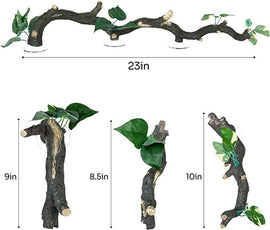At Repti-Zoo, we understand that providing the ideal habitat for your pet lizard is essential for their health and well-being. In this comprehensive guide, we’ll delve into the intricacies of creating optimal Lizard tank/cage/habitat, cages, and habitats to ensure your scaly friend thrives in captivity.
Choosing the Right Type of Enclosure
1. Terrariums vs. Vivariums
Understanding the distinction between terrariums and vivariums is crucial. While terrariums are primarily designed for terrestrial species, vivariums incorporate elements for both land and water, catering to semi-aquatic or arboreal lizard species.
2. Tank Size Matters
Selecting an appropriately sized tank is paramount. Larger species require more space for movement. As a general guideline, provide at least one square foot of space for every six inches of lizard length. Consider the adult size of your lizard when choosing the tank.
3. Enclosure Material
Choose materials that are easy to clean and provide proper insulation. Glass and plastic are popular choices, offering visibility and durability. Ensure proper ventilation to maintain optimal air circulation within the enclosure.
Designing the Ideal Habitat
1. Substrate Selection
Selecting the right substrate is crucial for replicating your lizard’s natural environment. Options include coconut coir, cypress mulch, or reptile carpet, depending on the species. Ensure the substrate is easy to clean and maintain.
2. Cage Furnishings
Enhance the habitat with cage furnishings such as branches, rocks, and hiding spots. These elements provide opportunities for climbing, basking, and exploring, enriching your lizard’s daily activities.
3. Temperature and Lighting
Maintaining proper temperature gradients is vital. Provide a basking spot with a temperature range of 85 to 95 degrees Fahrenheit, complemented by a cooler area ranging from 75 to 85 degrees Fahrenheit. Use UVB lighting to support your lizard’s calcium metabolism.
Species-Specific Considerations
1. Arboreal Lizards
For tree-dwelling species, incorporate vertical elements such as climbing branches and elevated platforms. Ensure the tank height accommodates their natural inclination to climb.
2. Terrestrial Lizards
Ground-dwelling lizards benefit from a substrate that allows digging and burrowing. Provide ample hiding spots and flat surfaces for basking.
3. Semi-Aquatic Lizards
For species with aquatic tendencies, include a water feature with a suitable depth. Ensure a gradual slope for easy access, and monitor water quality regularly.
Maintenance and Monitoring
1. Regular Cleaning
Maintain a clean enclosure by removing waste, replacing soiled substrate, and sanitizing surfaces. Regular cleaning prevents the buildup of harmful bacteria and ensures a hygienic environment.
2. Health Monitoring
Observe your lizard’s behavior regularly. Changes in appetite, activity level, or skin appearance may indicate health issues. Prompt veterinary attention is crucial for early detection and intervention.
Conclusion
In conclusion, creating a comprehensive and species-specific habitat for your pet lizard involves careful consideration of enclosure type, size, furnishings, and maintenance practices. By understanding the unique needs of your lizard and providing a well-designed and maintained habitat, you contribute to their overall health, happiness, and longevity.



